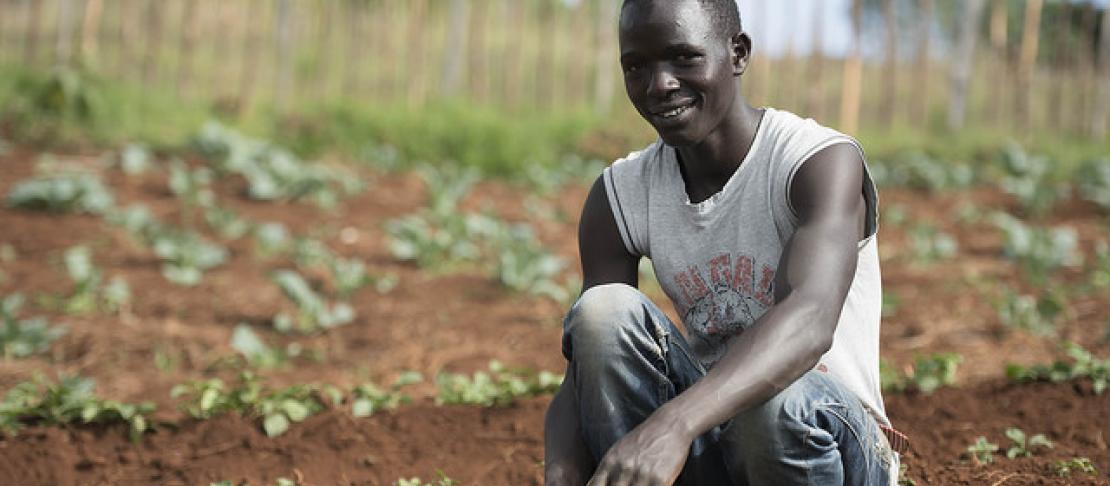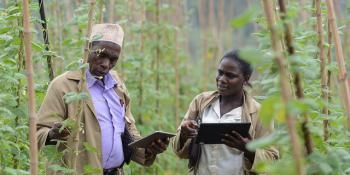Encouraging African youth to adopt climate-smart agriculture

What partnerships, innovations, and financing opportunities are available for young people in Africa to adopt climate-smart agriculture? Here are some highlights from our recent online discussion.
Twelve million young people enter the African workforce each year with only roughly 3 million jobs available to them. To many, an agricultural career is not a glamorous prospect, particularly as climate change degrades land and disrupts weather patterns, making it harder for farmers to grow enough to feed even their own households.
In a recent online discussion about partnerships, innovations and financing for youth in climate-smart agtriculture (CSA), participants shared their thoughts around encouraging youth to take up agriculture as a career and adopt CSA.
Innovations
Respondents agreed that integrating information and communication technologies (ICTs) into CSA can be attractive to youth.
In my opinion, the only way to attract youth to CSA is to make it more appealing to the young people. This can be made possible through integrating technology in CSA. Not just technology but easily accessible technology which will allow the young people to conduct some operations from the comfort of their smartphones.”
Some participants shared good examples of such innovations, for instance: ESAFF Uganda piloted a platform to give farmers farming tips, and weather and market information, and the initiative was most popular among the youth. Another example came from a member of the Zimbabwe Farmers’ Union (ZFU) that partnered with a local mobile operator and other service providers to scale up tested climate-resilient solutions such as weather-based index insurance, ICT-enabled climate information, and production advisory services.
Read more comments about what innovations can be employed to make CSA more attractive to youth.
Partnerships
Partnerships are key to fostering CSA in Africa but also have limitations, concluded some participants who took part in the discussion.
Partnership comes with advantages and disadvantages depending on different circumstances. If policies and procedures are followed properly between all parties then it can be beneficial to all parties… For these partnerships to work, all parties must get benefits according to the energy they invest and must agree before commencing.”
One respondent, Nche Tala, explained that as CSA encompasses varied domains of specialization such as agriculture, agribusiness, environment, and development in general, it is difficult to find a particular institution/organization that is grounded in or better still has a complete mastery of all domains. "I therefore strongly believe that actively engaging in STRATEGIC PARTNERSHIPS with organizations as well as academic institutions with a rich knowledge acquired through specialization in a particular aspect or domain of CSA, offers the opportunity to tailor projects that are concrete and that can bring about meaningful change.”
Read more comments about how partnerships affect and influence CSA in Africa.
Know of any successful case studies we can learn from? What is increasingly emerging is the need for mentors and also real-life cases of young people who are 'making it' through CSA to inspire their peers. https://t.co/dxpHP5yMrJ
— Catherine Mungai (@catmungai) 2018. április 25.
Financing opportunities
Appropriate and inclusive financial services can equip youth with the resources and support they need to become productive and economically active and make the transition from childhood to adulthood. Participants shared their thoughts and experiences about financing opportunities for youth:
In Kenya, there’s the youth fund where youths can access funds for an array of activities but there’s not yet a funding mechanism that’s only aimed at enhancing climate-smart agriculture adoption amongst the youth, despite of the availability of the youth fund, logistical issues has made it hard for youths to access the funds in a stress-free way, one has to know someone who knows someone in order to access the youth fund. In my opinion for any funding mechanism to be convenient enough for all in almost every region in Africa there’s need for the issue of good governance to be taken into consideration.”
There is a need to make CSA activities attractive and accessible to youth. This means exploring and introducing more business- and market-oriented approaches to agriculture for youth engagement in the sector, as well as making the agricultural sector a more productive and attractive profession.
The government, private sector, and development partners need to play a central role in the development of CSA technologies, creating new employment opportunities for young people, nurturing linkages between education and business, and improving access to markets, financial services and innovation, as well as in the transfer of technology and skills.
Read more:
- Online discussion: Partnerships, innovations and financing for youth in climate-smart agriculture
- Report: Youth Engagement in Climate-Smart Agriculture in Africa: Opportunities and Challenges
- Blog: Leave no one behind: the youth also have a say in the Koronivia Joint Work on Agriculture
The online discussion was organized by the Climate Smart Agriculture Youth Network (CSAYN) and the CGIAR Research Program on Climate Change, Agriculture and Food Security (CCAFS), with support from the Global Alliance on Climate Smart-Agriculture (GACSA), the Technical Center for Agriculture and Rural Cooperation (CTA), African Forum for Agricultural Advisory Services (AFAAS), ICCO Cooperation and AgriProfocus.
Lili Szilagyi is the Communications Consultant for CCAFS East Africa.



